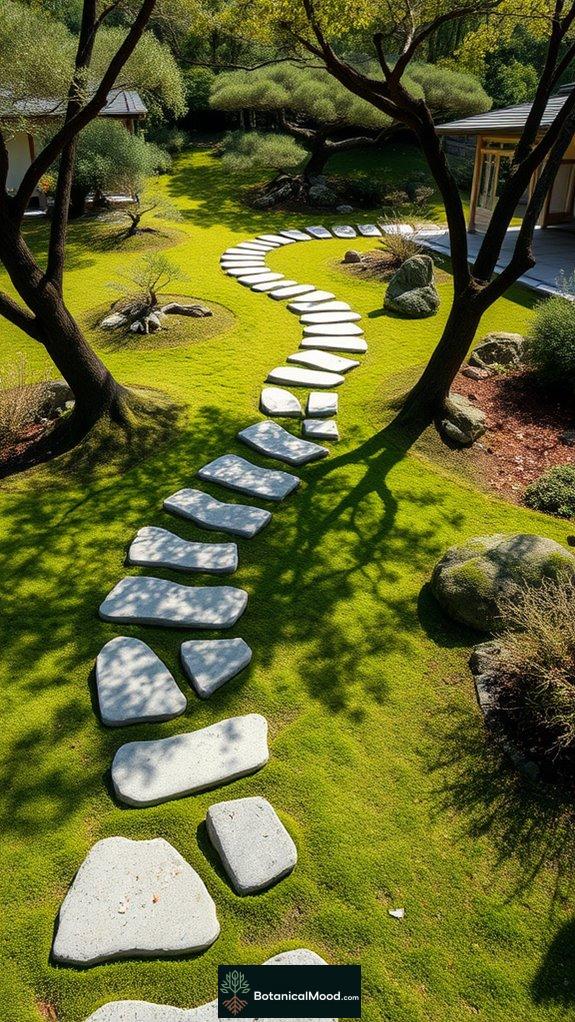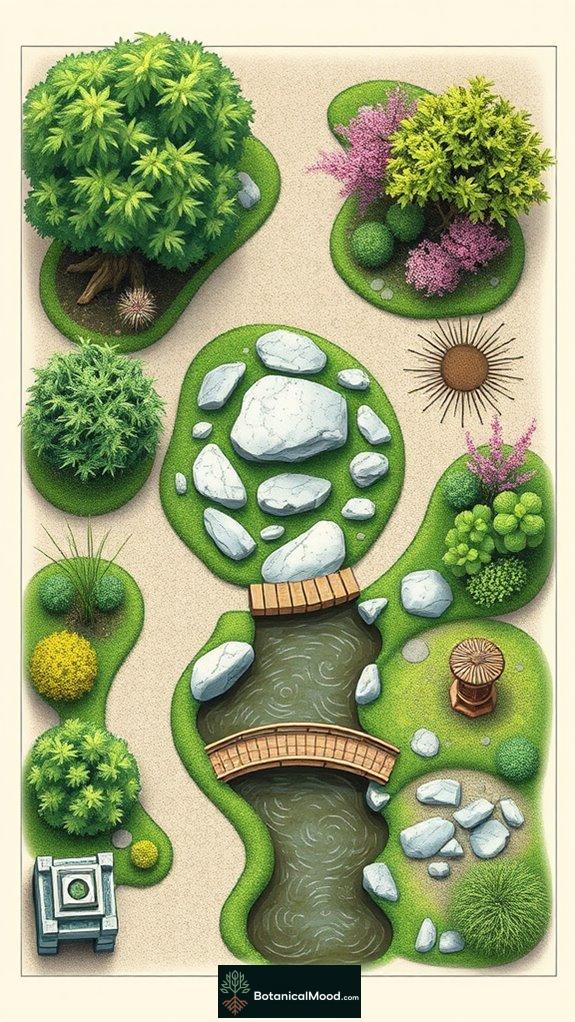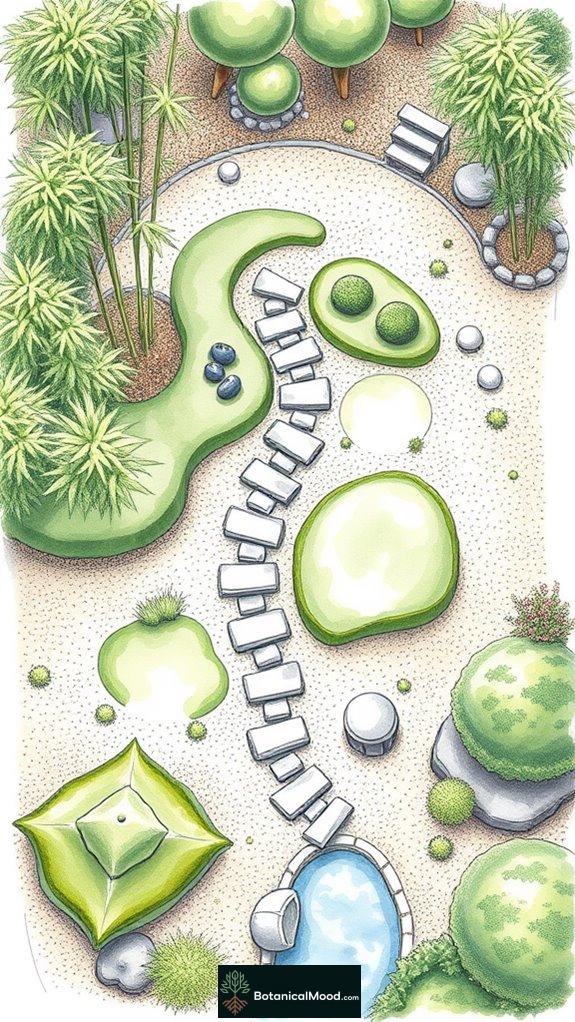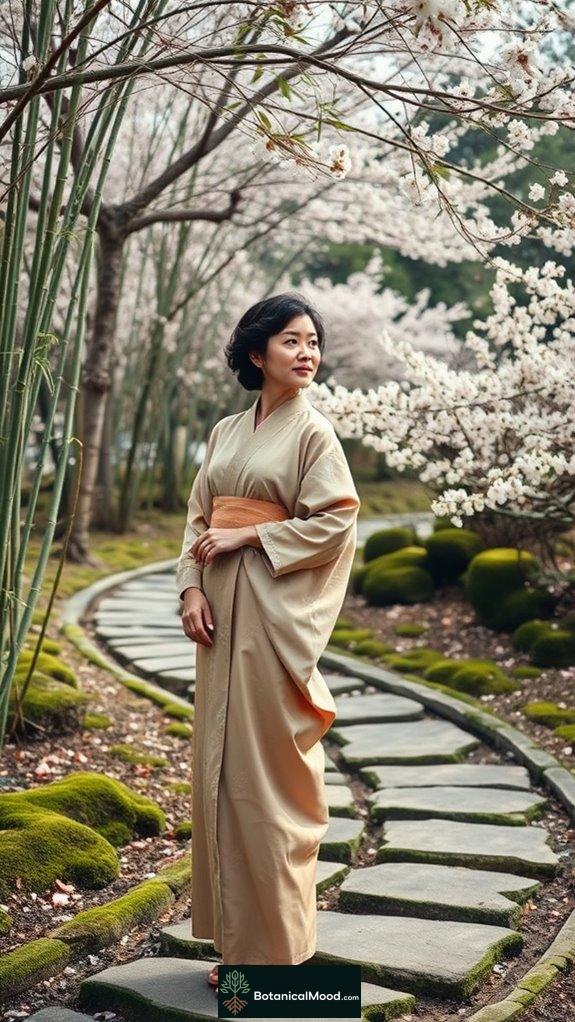Japanese gardens reveal harmony through the sacred arrangement of stones, meticulously crafted to embody balance and tranquility. Kare-sansui designs showcase minimalist aesthetics that emphasize natural beauty, while stepping stones guide visitors along mindful paths, reflecting life's journeys. Asymmetrical stone arrangements create visual focus, inviting contemplation. Symbolic hills and serene ponds in Tsuki-yama gardens enhance the serene atmosphere. Through the elements of design, such gardens foster a deeper connection with nature and inspire exploration of their elaborate beauty, inviting further discovery.
Quick Takeaways
- Sacred stones in Japanese gardens symbolize permanence, guiding visitors through a harmonious experience with nature and fostering mindfulness.
- The minimalist design of Kare-Sansui gardens emphasizes balance and emptiness, creating a serene atmosphere that invites silence and contemplation.
- Stepping stones (tobi-ishi) encourage mindful navigation, reflecting life's journey while maintaining cleanliness and enhancing the garden's tranquility.
- Asymmetrical stone arrangements, like the Sanzon-ishigumi technique, promote organic beauty and serve as focal points for spiritual reflection.
- Elements like lanterns and curvilinear pathways create sacred markers, inviting visitors to explore and connect deeply with the garden's serene environment.
Embracing Nature With Kare-Sansui Designs

When I first encountered kare-sansui gardens, I was struck by how they effortlessly embrace nature while embodying a deep philosophical message. These gardens exemplify natural harmony through carefully selected elements, like stones and gravel, representing mountains and rivers. The design principles focus on balance, simplicity, and the beauty of emptiness, inviting contemplation. The importance of raking in these gardens adds a unique texture and imagery that enhances the overall experience. Additionally, the use of natural stone in various forms creates a sense of permanence and connection to the earth. I admire the dynamic patterns raked into the gravel, mimicking water's flow, which adds depth to the scenery. As I explore these serene spaces, I appreciate how they reflect a timeless connection to nature, inspiring my passion for garden design, which I share on my website, Botanical Mood.
The Pathways of Contemplation: Stepping Stones

As I wander through a Japanese garden, the stepping stones, or *tobi-ishi*, beckon me to explore their thoughtful arrangement, guiding my steps while keeping my clothes clean and dry.
Each stone represents more than just a path; they embody stepping stone symbolism, reflecting our journeys through life and towards enlightenment.
Mindful navigation becomes essential as I traverse the winding paths, each turn revealing new viewpoints.
The irregular placement of these stones invites me to slow down, fostering a deeper connection with the scenery.
In modern Japanese rock gardens, the design often emphasizes asymmetrical balance, creating a harmonious flow that enhances the overall tranquility of the space.
I created this website, Botanical Mood, to share this appreciation for beauty and design in gardens, inspiring others to cultivate their own tranquil spaces.
Creating Visual Focus Through Stone Arrangements

Creating visual focus in a Japanese garden often hinges on the thoughtful arrangement of stones. One powerful technique is the Sanzon-ishigumi, featuring a dominant, tall stone surrounded by two smaller ones.
This triadic composition not only draws the eye but embodies stone symbolism, representing spiritual elements like Buddha and two Bodhisattvas.
Asymmetrical arrangements enhance visual harmony, mimicking the natural world's organic beauty. By balancing these stones with careful intent, I endeavor to create a space that invites contemplation and connection. Incorporating minimalist design principles can further amplify the serene atmosphere of the garden.
My passion for garden design inspired me to share perspectives on achieving this harmony through stone arrangements on Botanical Mood.
Symbolic Hills and Ponds: The Art of Tsuki-yama

The enchanting world of Tsuki-yama gardens invites us to investigate the delicate balance between art and nature through their symbolic hills and ponds.
These gardens, designed to replicate natural scenery, offer us a unique viewpoint on natural harmony, featuring:
- Hills that symbolize majestic mountains.
- Ponds representing tranquil seas or lakes.
- A variety of native plants enhancing realism.
Each element harmonizes to create symbolic vistas that reflect Japanese cultural values.
As I explore these complex designs on Botanical Mood, I appreciate how they foster serenity and contemplation, reminding us of our connection to nature's beauty.
Minimalist Aesthetics in Hira-niwa Gardens

While exploring Hira-niwa gardens, I find myself captivated by their minimalist aesthetics that celebrate simplicity and tranquility.
Each garden's design emphasizes negative space, or ma, which enhances visual harmony and allows for deep contemplation.
The raked gravel, symbolizing water, creates a serene backdrop, while strategically placed rocks evoke mountains and islands.
Minimalist plant selection contributes to the overall hira niwa aesthetics, focusing on beauty and symbolism.
In crafting Botanical Mood, I aimed to highlight such innovative designs, showcasing how these gardens embody minimalist beauty and encourage a peaceful connection to nature, inviting us to appreciate the elegance of simplicity.
The Significance of Ornaments: Bridges and Lanterns

Ornaments like bridges and lanterns play an essential role in enhancing the beauty and meaning of Japanese gardens, complementing the minimalist aesthetics found in Hira-niwa gardens.
- Lantern Placement: Lanterns serve as sacred markers, guiding spirits and creating tranquil spaces.
- Historical Significance: Their designs reflect cultural heritage, often telling stories of the past.
- Bridges for Reflection: They connect different garden areas, inviting contemplation and enhancing scenic views.
Through careful integration of these elements, I believe we can appreciate the profound artistry behind Japanese gardens, which inspired my creation of Botanical Mood.
Asymmetrical Stone Placement Technique

As I explore the complex world of Japanese gardens, I find that asymmetrical stone placement is a technique that beautifully captures the essence of nature.
This method creates an enchanting asymmetrical balance, mimicking the irregular patterns of the natural scenery. Choosing stones based on their unique forms enhances stone harmony while respecting the ancient guidance of the "Sakuteiki."
I've learned that odd-numbered arrangements, like three or five stones, evoke a visually appealing rhythm. By placing smaller stones to support larger ones, we establish stability, allowing each stone to tell its story, contributing to the garden's overall serenity and beauty.
Curvilinear Pathway Arrangement

Curvilinear pathways invite exploration and discovery, transforming a garden into a personal journey.
These winding paths create a sensory experience that captivates the visitor's attention.
- Bamboo-lined trails encourage a natural flow, guiding you through lush surroundings.
- Stepping stones prompt mindful walking, each step a moment of contemplation.
- Moss-covered stones add texture, embodying the beauty of imperfection.
With innovative pathway materials, such as weather-resistant woods and gravel, the design integrates seamlessly into nature.
I created this website, Botanical Mood, to share perspectives on how these elements harmonize, enriching our connection to the tranquil beauty of Japanese gardens.
Garden's Visionary Creator

Visionary creators shape the terrains of Japanese gardens, blending artistry with nature to craft serene havens that invite reflection and tranquility.
Frank Fujii and Koichi Kawana stand out as pivotal figures in the garden's history, each contributing unique expertise to its evolution. Fujii, working with Madame Ganna Walska, enhanced Lotusland's Japanese Garden, infusing it with harmony and elegance.
Kawana's design at the Missouri Botanical Garden echoed the strolling gardens of 19th-century Japan, emphasizing natural elements like lakes and hills.
Their innovative approaches epitomize the connection between tradition and modernity, showcasing how Japanese gardens continue to inspire and transform our understanding of beauty.
References
- https://www.gardendesignacademy.co.uk/blog/essential-elements-of-a-japanese-garden
- https://designdestinations.org/2020/11/japanese-gardens-calm-the-mind/
- https://www.britannica.com/art/Japanese-garden
- https://pacifichorticulture.org/articles/lessons-from-the-japanese-garden-revisited/
- https://www.greengoldlandscapinginc.com/japanese-garden-design-principles/
- https://najga.org/7-common-raking-patterns-in-japanese-dry-landscape-gardens/
- https://danslegris.com/blogs/journal/japanese-zen-garden
- https://matcha-jp.com/en/2727
- https://gardenartisans.com/blog/embrace-the-tranquility-of-japanese-garden-design/
- https://japanhouse.illinois.edu/about/dry-garden

Leave a Reply